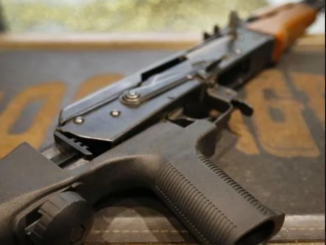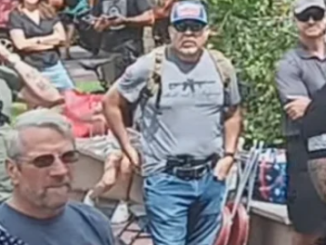
Last June in New York State Rifle and Pistol Association v. Bruen, the Supreme Court ruled that it was unconstitutional to require that people who want to carry handguns in public for self-defense demonstrate that they have “proper cause” to do so. New York legislators and Gov. Kathy Hochul responded by eliminating that requirement while simultaneously imposing a raft of new restrictions, including criteria for proving a carry-permit applicant’s “good moral character” and bans on firearm possession in a long list of “sensitive locations.” Yesterday a federal judge issued a temporary restraining order (TRO) against enforcing many of those rules, saying they probably violate the Second Amendment.
U.S. District Judge Glenn T. Suddaby’s decision in Antonyuk v. Hochul casts doubt on the constitutionality of the vague standards that New York and several other states retained even after Bruen. It also suggests that sweeping, location-specific gun bans like New York’s, which make leaving home with a gun legally perilous even for permit holders, are inconsistent with the constitutional right to bear arms.
Suddaby notes that New York’s law “expressly prohibits the issuance of a license [to carry a handgun] unless the licensing officer finds (meaning unless the applicant persuades him or her through providing much information, including ‘such other information required by review of the licensing application that is reasonably necessary and related to the review of the licensing application’) that the applicant is of ‘good moral character,’ which involves undefined assessments of ‘temperament,’ ‘judgment’ and ‘[]trust[].'” He adds that “shouldering an applicant with the burden of showing that he or she is of such ‘good moral character’ (in the face of a de facto presumption that he or she is not) is akin to shouldering an applicant with the burden of showing that he or she has a special need for self-protection distinguishable from that of the general community.”
That is exactly the sort of requirement that the Supreme Court rejected in Bruen, which said New York’s “may issue” permit policy, in contrast with “shall issue” laws that allow people to carry guns if they meet a short list of objective criteria, gave local officials too much discretion. “In essence,” Suddaby says, “New York State has replaced its requirement that an applicant show a special need for self-protection with its requirement that the applicant rebut the presumption that he or she is a danger to himself or herself, while retaining (and even expanding) the open-ended discretion afforded to its licensing officers. Simply stated, instead of moving toward becoming a shall-issue jurisdiction, New York State has further entrenched itself as a shall-not-issue jurisdiction.”
Suddaby’s TRO also applies to New York’s requirement that applicants supply information about their social media accounts so that licensing officials can decide whether they have said anything suggesting they lack “good moral character.” As the gun owners who challenged the new regulations saw it, that demand violated the right to freedom of speech as well as the right to bear arms, making the latter contingent on how applicants have exercised the former.
Suddaby also blocked enforcement of New York’s requirement that carry-permit applicants meet in person with licensing officials for an interview, saying “the
Court finds that no such circumstances exist under which this provision would be valid.” He likewise said the state had failed to justify its demand for the “names and contact information for the applicant’s current spouse, or domestic partner, any other adults residing in the applicant’s home, including any adult children of the applicant, and whether or not there are minors residing, full time or part time, in the applicant’s home.” Suddaby deemed that requirement “far more invasive and onerous” than the requirement that an applicant supply four character references, which he let stand.
In analyzing whether these provisions were likely to pass constitutional muster, Suddaby applied the test that the Supreme Court prescribed in Bruen: whether a rule is “consistent with this Nation’s historical tradition of firearm regulation.” Meeting that test requires citing historical analogs that resemble the challenged restriction, which New York had trouble doing for several of its rules.
The state’s justification for the character-reference requirement, for example, relied on three historical analogs, including a Delaware law that said “any free negro or free mulatto” who wanted permission to carry a gun had to submit the “written certificate of five or more respectable and judicious citizens of the neighborhood” attesting to his “fair character.” In a footnote, Suddaby notes that he took that precedent into account despite its “racist and abhorrent” nature. New York also cited two municipal ordinances regulating public possession of guns, one requiring a police recommendation and one requiring references from “at least three reputable freeholders.”
That thin record was enough for Suddaby to let New York demand that a carry-permit applicant submit four character references. But he said the state had not shown that its expansive definition of “sensitive locations” was consistent with the historical understanding of the right to bear arms.
“The Court respectfully reminds Defendants that, because the Second Amendment’s plain text covers the conduct in question (carrying a handgun in public for self-defense), ‘the Constitution presumptively protects that conduct,'” Suddaby writes. “Defendants must then rebut the presumption by ‘demonstrat[ing] that the regulation is consistent with this Nation’s historical tradition of firearm regulation.'”
In the landmark Second Amendment case District of Columbia v. Heller (2008), the Supreme Court described “laws forbidding the carrying of firearms in sensitive places such as schools and government buildings” as “longstanding prohibitions.” But in Bruen, it noted that “the historical record yields relatively few 18th- and 19th-century ‘sensitive places’ where weapons were altogether prohibited.” They included “legislative assemblies, polling places, and courthouses.”
New York’s location-specific gun bans, by contrast, include 20 broad categories that encompass myriad places where people might want to carry firearms for self-defense. Suddaby rejected many of these restrictions, including the prohibition of firearms in public transportation, in entertainment venues, in places where alcohol is served, and in “the area commonly known as Times Square.” He said the ban on guns in places of worship was overly broad because it did not include an exception for “persons who have been tasked with the duty to keep the peace” in such locations.
More generally, Suddaby rejected New York’s default rule that guns are prohibited in all businesses open to the public unless the owner expressly allows them and posts signs to that effect. Contrary to the state’s claim that it is defending the prerogatives of business owners, he says, New York is “making a decision for private property owners that they are perfectly able to make for themselves…as well as arguably compelling speech on a sensitive issue.” In any case, he adds, “this policy dispute is irrelevant, because it does not regard the Supreme Court’s ‘historical tradition’ standard.”
That standard may prove to be an insurmountable challenge for states that pretend to comply with Bruen while imposing licensing requirements just as nebulous as the “proper cause” test that Court rejected or making it practically difficult for permit holders to carry guns for self-defense. Judging from Suddaby’s decision, courts may not be as easy to fool as anti-gun politicians hope.
* Article from: reason.com


